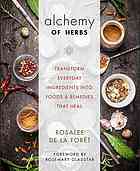Alchemy of Herbs. Transform Everyday Ingredients into Foods and Remedies that Heal. / Rosalee de la Foret, 2017. Hay House, Inc. 355 pages, color illustrations.

Alchemy, an ancient science of transformation, is really a form of translation—taking the inherent potency of a living plant to the level of a healing medicine we entrust our health to. Alchemy is recently a favorite word for many things, but you’ll want #learningherbs or the author’s name, Rosalee De La Foret on social media.
Apart from its curious but believable title, the book is attractively presented. From its cover to the pages in each chapter, photographs were taken by the author, and the whole layout of pages is evocative of an herbalist’s personal cookbook. Bright and clear photos inspire you to read deeply into the text, and to discover what sort of alchemy you might be good at.
Although herbalists would agree that preparing the herbs requires experience and skill, once you possess these in the kitchen for daily vegetable fare, you’re ready to experiment with herbs. Finding the ones most suited to your needs is an easy and enjoyable task with Alchemy of Herbs.
I actually like the author’s selection of culinary and medicinal herbs in Alchemy of Herbs. Use their distinctive tastes as an organizing principle and each of the 28 herbs will match one of the five tastes recognized on the human tongue. With pungent, salty, bitter, sour and sweet herbs and spices, author Rosalee De La Foret shows you the benefits of matching herbal properties and medicinal uses, and how to feature each herb’s flavor in both your kitchen and your herbal preparations for everyday cures. Maximize the potent quality of taste in your daily diet to benefit from life-enhancing powers of herbs for you and your family.
Of the five categories of tastes, the largest category is pungent. Here De La Foret portrays many well known herbs and spices like black pepper, cayenne, cinnamon, garlic and 12 more. With recipes for Garlic honey, chia seed pudding with Cinnamon-maple syrup, Peppery borsht and Fire Cider, a reader can play with these powerful herbs in creative ways. It’s knowing about the double lives of herbs that forms a complete picture of their qualities—pungent, salty, sour, bitter, or sweet—and how to use them to the best advantage.
De La Foret introduces each of the herbs in her collection with a profile that shows the history of human use, as medicines and for food. A few of the herbs have been popular for thousands of years! One of the oldest might be Holy Basil (Ocimum sanctum). Known in the marketplace as Tulsi, an Ayurvedic name for Holy Basil, it’s been prized for 3,000 years! You’ve likely seen or purchased Tulsi Tea: it’s from the plant Holy Basil, rather than everyday basil (Ocimum basilicum) used in Mediterranean food—Greek, Italian, and in Thai recipes* for its delicious, pungent flavor. Tulsi has abundant qualities, offering calming effects is just one of them.
Each herb profile features information on energetics—whether it has cooling and slowing or warming and moving properties. Then the profile details what kinds of medicinal support it lends—in the case of Holy Basil—to anxiety and stress, your brain’s health, insulin resistance and type 2 diabetes, cardiovascular issues, pain, digestion, your lungs, and immune system. An herb with that wide a range of healing capacity could be quite valuable to know about!
Pungent herbs have a quality that creates a strong taste sensation on your tongue and an after-effect of digestion termed “warming and drying”. Used as the primary ingredient in a remedy, these herbs are good for people who are cold, who feel cold easily, or whose constitution is airy and ungrounded, or sluggish.
Likewise, sour is a quality that gives digestion a boost, in this case from its “cooling and drying” nature. And sweet herbs help support rejuvenation, while salty herbs deliver minerals just like vegetables do. In fact, nettles, a salty herb is a favorite food among herbalists.
While pungent herbs are basically warming and drying, bitter herbs can be warming or cooling—they are mixed in their energetic properties. De La Foret maintains that while herbs are exploited for their capacity to balance specific conditions, use of a hot herb in recipes is counterbalanced for taste and for use by anyone, just like the balance of ingredients in recipes, such as salsa, usually are
So go ahead and try your hand at herbal alchemy! With these recipes, whether with pungent, sour, sweet, bitter or salty give your digestion and well-being the support it needs for long term health!
Follow


